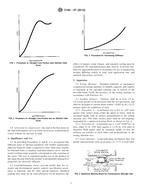We need your consent to use the individual data so that you can see information about your interests, among other things. Click "OK" to give your consent.
ASTM C165-07(2012)
Standard Test Method for Measuring Compressive Properties of Thermal Insulations
STANDARD published on 1.9.2012
The information about the standard:
Designation standards: ASTM C165-07(2012)
Note: WITHDRAWN
Publication date standards: 1.9.2012
SKU: NS-12117
The number of pages: 5
Approximate weight : 15 g (0.03 lbs)
Country: American technical standard
Category: Technical standards ASTM
The category - similar standards:
Annotation of standard text ASTM C165-07(2012) :
Keywords:
blanket-type, block-type, board-type, compression testing, compressive resistance, deformation, modulus of elasticity, thermal insulation, thermal insulation materials, ICS Number Code 91.100.60 (Thermal and sound insulating materials)
Additional information
| Significance and Use | ||||||||||||
|
4.1 In providing Procedures A and B, it is recognized that different types of thermal insulation will exhibit significantly different behavior under compressive load. Data must usually be obtained from a complete load-deformation curve, and the useful working range normally corresponds to only a portion of the curve. The user is cautioned against use of the product in the range beyond which the product is permanently damaged or properties are adversely affected. 4.2 Load-deformation curves provide useful data for research and development, quality control, specification acceptance or rejection, and for other special purposes. Standard loading rates shall not be used arbitrarily for all purposes; the effects of impact, creep, fatigue, and repeated cycling must be considered. All load-deformation data shall be reviewed carefully for applicability prior to acceptance for use in engineering designs differing widely in load, load application rate, and material dimensions involved. |
||||||||||||
| 1. Scope | ||||||||||||
|
1.1 This test method covers two procedures for determining the compressive resistance of thermal insulations. 1.1.1 Procedure A covers thermal insulations having an approximate straight-line portion of a load-deformation curve, with or without an identifiable yield point as shown in 1.1.2 Procedure B covers thermal insulations that become increasingly more stiff as load is increased, as shown in 1.2 It is recognized that the classification of materials under Procedures A and B shall not hold in all cases. For example, some batt or blanket materials that have not been compression packaged will exhibit behavior more typical of Procedure A for their first loadings. Also, some higher density fibrous insulation boards that have been precompressed will exhibit load-deformation curves more typical of Procedure B. There will also be thermal insulations with load-deformation curves that follow none of the three types shown here; that is, curves with no straight-line portion, curves with compaction areas, and curves that change from negative to positive slope. 1.3 This test method does not cover reflective or loose fill insulations. 1.4 The values stated in inch-pound units are to be regarded as the standard. The values given in parentheses are for information only. 1.5 This standard does not purport to address all of the safety concerns, if any, associated with its use. It is the responsibility of the user of this standard to establish appropriate safety and health practices and determine the applicability of regulatory limitations prior to use. |
||||||||||||
| 2. Referenced Documents | ||||||||||||
|
Similar standards:
Historical
1.4.2013
Historical
1.5.2013
Historical
1.9.2014
Historical
1.9.2014
Historical
1.5.2014
Historical
1.9.2014
We recommend:
Technical standards updating
Do you want to make sure you use only the valid technical standards?
We can offer you a solution which will provide you a monthly overview concerning the updating of standards which you use.
Would you like to know more? Look at this page.



 ASTM C168-13
ASTM C168-13 ASTM C1728-13
ASTM C1728-13 ASTM C1729-14a
ASTM C1729-14a ASTM C1729M-14a
ASTM C1729M-14a ASTM C1763-14
ASTM C1763-14 ASTM C1767-14a
ASTM C1767-14a
 Cookies
Cookies
